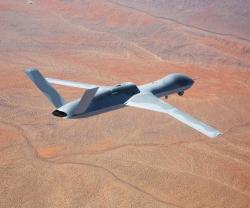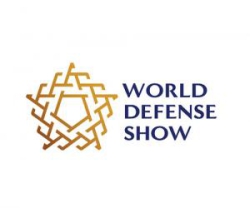GA-ASI: Key Wind Tunnel Test on Sea Avenger UAS
16.02.2011 North America
General Atomics Aeronautical Systems, Inc. (GA ASI), a leading manufacturer of unmanned aircraft systems (UAS), tactical reconnaissance radars, and sensor systems, today announced that it has successfully completed a key wind tunnel test on a model of its Sea AvengerTMUAS. Sea Avenger supports the Unmanned Carrier-Launched Airborne Surveillance and Strike (UCLASS) program by providing a long-endurance, survivable, carrier-based UAS for the U.S. Navy.
The wind tunnel test validated the low-speed characteristics of a new wing, resulting in higher endurance and lower approach speeds. The new wing is also designed to increase aircraft dash speeds, decreasing the time to respond to potential threats.
“GA-ASI is committed to providing the Navy with swift delivery of a robust and versatile aircraft carrier-based UAS that meets or exceeds known requirements, provides measurable manpower savings, and assures best value,” said Frank W. Pace, President, Aircraft Systems Group, General Atomics Aeronautical Systems, Inc. “Reducing risk is a key component of this process, and our company has repeatedly designed and delivered low-cost, high-quality UAS, in part, because of our recurring commitment to invest in early development, as evidenced by this recent wind tunnel test.”
The 90-hour, eight-day test was conducted at the San Diego Air & Space Technology Center. The goal of the test, which was completed ahead of schedule, was to validate the low-speed characteristics of an updated wing in the approach, launch, and cruise configurations. The advanced design utilizes proprietary wing technology that enables high-speed flight, while also supporting excellent low-speed handling qualities desired for aircraft carrier landings.
The testing enabled GA-ASI to evaluate a specific set of configuration changes both quickly and economically. Wind tunnel testing also helps reduce program risk by providing empirical data to complement computational analyses. In addition, it provides the opportunity to correlate key performance data to analytical tools, such as computational fluid dynamics, and to validate various analytical methods.
Designed for fully autonomous launch and recovery from both USS Nimitz and USS Ford class carriers, Sea Avenger provides unmanned, autonomous, and long-endurance Intelligence, Surveillance, and Reconnaissance (ISR) capabilities responsive to the multi-mission requirements of carrier-based aircraft. The aircraft will provide for planning, control, tasking, collection, processing, analysis, and dissemination of actionable information in support of Navy missions. An evolution of the combat-proven Predator® UAS series with high-performance maritime payloads, Sea Avenger provides the highest operational value while being the only affordable system capable of meeting the Navy’s aggressive program schedule.
The wind tunnel test validated the low-speed characteristics of a new wing, resulting in higher endurance and lower approach speeds. The new wing is also designed to increase aircraft dash speeds, decreasing the time to respond to potential threats.
“GA-ASI is committed to providing the Navy with swift delivery of a robust and versatile aircraft carrier-based UAS that meets or exceeds known requirements, provides measurable manpower savings, and assures best value,” said Frank W. Pace, President, Aircraft Systems Group, General Atomics Aeronautical Systems, Inc. “Reducing risk is a key component of this process, and our company has repeatedly designed and delivered low-cost, high-quality UAS, in part, because of our recurring commitment to invest in early development, as evidenced by this recent wind tunnel test.”
The 90-hour, eight-day test was conducted at the San Diego Air & Space Technology Center. The goal of the test, which was completed ahead of schedule, was to validate the low-speed characteristics of an updated wing in the approach, launch, and cruise configurations. The advanced design utilizes proprietary wing technology that enables high-speed flight, while also supporting excellent low-speed handling qualities desired for aircraft carrier landings.
The testing enabled GA-ASI to evaluate a specific set of configuration changes both quickly and economically. Wind tunnel testing also helps reduce program risk by providing empirical data to complement computational analyses. In addition, it provides the opportunity to correlate key performance data to analytical tools, such as computational fluid dynamics, and to validate various analytical methods.
Designed for fully autonomous launch and recovery from both USS Nimitz and USS Ford class carriers, Sea Avenger provides unmanned, autonomous, and long-endurance Intelligence, Surveillance, and Reconnaissance (ISR) capabilities responsive to the multi-mission requirements of carrier-based aircraft. The aircraft will provide for planning, control, tasking, collection, processing, analysis, and dissemination of actionable information in support of Navy missions. An evolution of the combat-proven Predator® UAS series with high-performance maritime payloads, Sea Avenger provides the highest operational value while being the only affordable system capable of meeting the Navy’s aggressive program schedule.
Previous PostCOPPER-MATRIX® SX for Realistic Urban Training
Latest news
Latest events
Doha International Maritime Defence Exhibition & Conference (DIMDEX 2026)
19 - 22 Jan 2026Doha - QatarUMEX – SimTEX
20 - 22 Jan 2026ADNEC Centre Abu Dhabi, - United Arab EmiratesWorld Defense Show (WDS) 2026
08 - 12 Feb 2026Riyadh - Saudi ArabiaSAHA EXPO International Defence & Aerospace Exhibition
05 - 09 May 2026İstanbul Expo Center - Turkey






















